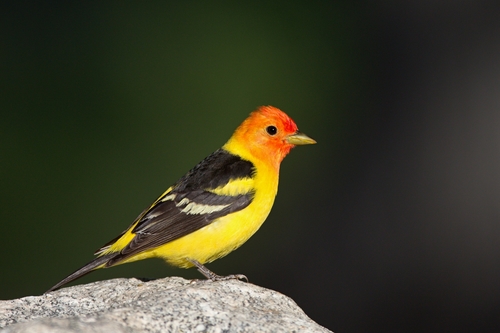
Western Tanager
The Western Tanager (*Piranga ludoviciana*) is a striking songbird known for the male's vibrant yellow body and bright red head during the breeding season. These birds are a common sight in the western forests of North America, playing a crucial role in their ecosystems as both seed dispersers and insectivores. They are migratory birds, spending their summers in western North America and wintering in Mexico and Central America. While not currently considered threatened, they face challenges from habitat loss and climate change.
16-19 cm
Length
28-30 cm
Wingspan
Least Concern
Conservation Status
Distribution
Breeds across western North America, from southeastern Alaska and the Northwest Territories of Canada, south through the Rocky Mountains and Pacific Coast states to northern Baja California, Mexico. Winters from central Mexico south to Costa Rica. Migrates through the western United States.
Lifespan
Up to 7 years in the wild, though average lifespan is likely shorter.
Western Tanager's Habitat
Habitat Types
Coniferous forests, Mixed woodlands, Open woodlands, Riparian areas
Climate Zones
Temperate, Boreal (breeding), Tropical (wintering)
Adaptations
Their preference for open woodlands and forest edges allows them to effectively forage for insects and find suitable nesting sites. Their migratory behavior allows them to exploit seasonally abundant resources.
Variations
No recognized subspecies, though slight variations in plumage and size may occur across their extensive range.
Appearance
Breeding Plumage
Breeding males have a bright red head, bright yellow body, and black back, wings, and tail. Females and non-breeding males are duller, with olive-green upperparts and yellowish underparts. The wings have two prominent wing bars, white and yellow.
Seasonal Feather Changes
Males molt into a duller plumage after breeding, losing much of their red head coloration.
Sex Based Plumage Differences
Significant. Males are much brighter and more distinctly patterned than females, especially during the breeding season.
Notable Features
Bright red head of breeding males, Two distinct wing bars, Relatively thick, pointed bill
Diet and Feeding
Primary Foods
Insects, Spiders, Fruits, Berries
Foraging Behavior
Gleans insects from foliage, often in the mid to upper levels of trees. Will also catch insects in flight (hawking). When feeding on fruits, they often perch on branches and pluck them.
Specializations
Their slightly thicker bill, compared to some other warblers, may be an adaptation for handling a wider variety of insect and fruit sizes.
Seasonal Diet Variations
Diet shifts with seasonal availability. Primarily insects during the breeding season; more fruits and berries in the fall and winter.
Behavior
Social Structure
Generally solitary or in pairs during the breeding season. May form small flocks during migration and on wintering grounds.
Communication
A burry, robin-like song, often described as 'pir-ri, pir-ri, pir-ri, pree', A dry, chattering call note, 'pit-er-ick'
Migration
Nocturnal migrants. Travel between breeding grounds in western North America and wintering grounds in Mexico and Central America.
Territorial or Group Behaviors
Males defend breeding territories through song and chasing away intruders. Territoriality is less pronounced during migration and on wintering grounds.
Conservation
Threats
Habitat loss (both breeding and wintering grounds), Climate change (altering insect emergence and fruit availability), Pesticide use (reducing insect prey), Collisions with buildings
Protection Programs
Protected under the Migratory Bird Treaty Act
Local National Laws
Migratory Bird Treaty Act (US, Canada, Mexico)
Population Trend
Slightly decreasing
Population Estimates
Approximately 13 million individuals.
Interesting Facts
The red pigment in the male's head feathers comes from a rare pigment called rhodoxanthin.
This pigment is not produced by the bird itself, but is acquired through their diet, likely from insects that feed on certain plants.
Western Tanagers are known to occasionally eat flower petals.
While not a major part of their diet, this behavior has been observed in various locations.
They can be attracted to bird feeders, especially with offerings of fruit and suet.
This provides an opportunity for close-up observation of these beautiful birds.
Faqs about Western Tanager
What do I do if I find an injured Western Tanager?
Contact a local wildlife rehabilitator. Do not attempt to care for the bird yourself, as they have specific dietary and care needs. *Consult a professional for medical or expert advice.*
Are Western Tanagers aggressive?
Males can be territorial during the breeding season, but they are generally not aggressive towards humans.
How can I attract Western Tanagers to my yard?
Plant native trees and shrubs that provide insects and fruits. Offer a source of fresh water. Avoid using pesticides.
Copyright @ Nature Style Limited. All Rights Reserved.
 English
English